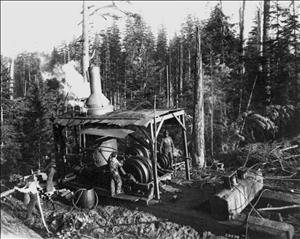On December 17, 1975, at 2:30 p.m., Palmer Coking Coal Company dynamited the portal to the Rogers No. 3 mine and the subsequent explosion closed the state's last underground coal mine, ending a significant chapter in the history of Washington. The Rogers No. 3 coal mine was located near the 262nd block just north of Kent Kangley Road in Ravensdale, King County. The mine was a continuation of the Rogers No. 1 and Rogers No. 2 portals where mining commenced in 1959 and 1960 respectively. In the late 1950s, Enoch Rogers, a bulldozer operator working for Palmer Coking Coal Company, Inc., discovered the coal seam that bears his name. This history of the last underground coal mine in Washington was written by William Kombol, manager of the Palmer Coking Coal Company, located in Black Diamond, King County, Washington.
The Rogers Coal Seam
The Rogers coal seam sits atop a gently sloping hill, which reaches a maximum elevation of 800 feet near the central portion of the mine site. The hill slopes downward towards the S.E. Summit Landsburg Road to the north and the Kent Kangley Road to the south.
The Rogers coal seam is unique in the annals of Washington state coal history as it has a near vertical dip. The seam is 16 feet wide and consists of coal, inter-bedded shale, and parting rock. The mine reached depths of up to 750 feet below the ground surface.
Mining was accomplished by drilling and blasting the seam with dynamite, causing the coal to cave into vertical chutes where it was machine loaded onto five-ton coal cars and transported out of the mine on rail. As a result of the caving during coal extraction, a subsidence trench developed on the land surface above the mine workings. The mine was operated on four levels separated by crosscuts and counter tunnels used for access, production, and circulation of fresh air throughout the mine.
During the 17 years of mining, 493,634 tons of clean coal was extracted from the Rogers No. 1, No. 2 and No. 3 mine. The operation typically supported a crew of 16 to 25 coal miners working two shifts. Surface facilities included a hoist, a machine shop, and a tipple with sorting screens and storage bunkers. Raw coal from the mine was transported by dump trucks from Ravensdale for cleaning and sizing at a coal preparation facility in Black Diamond known locally as the Mine No. 11 wash plant.
The Market
Most of the clean coal from the Rogers coal mine was sold to large institutional users such as the University of Washington in Seattle; the Rainier School in Buckley; the correctional facility in Shelton; and the reformatory in Monroe. During the 1960s and 1970s many state institutions began converting their fuel sources from coal to natural gas.
In addition, strict mine safety laws failed to recognize the unique nature of the mine's vertically dipping coal seam, which caused mining costs to increase rapidly. The declining market for coal coupled with the escalating production expenses resulted in the decision to close the Rogers No. 3 mine and underground coal mining in Washington came to an end.
The Future
Recent efforts to extract the energy value held in the billions of tons of coal in Washington have centered on surface mining and coal bed methane extraction. If price levels of world energy sources increase, there may yet be another chapter to write pertaining to the history of underground coal mining in the state of Washington.

